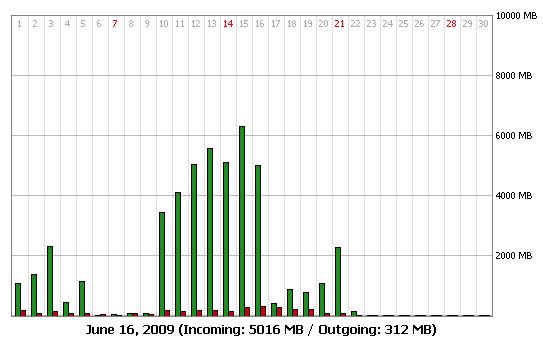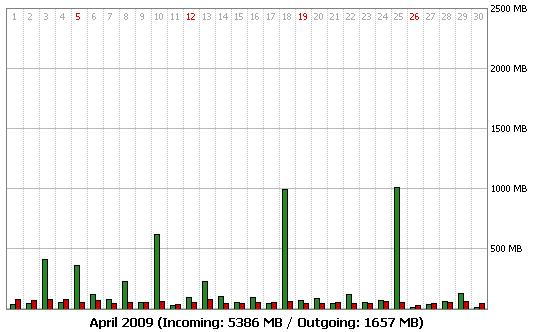I tend to use my browser state (and plenty of tabs) as lightweight bookmarks. This means leaving a couple of browser windows open perpetually. Often my machine is configured to sleep after about 20mins, but in the case of my work laptop it doesn’t sleep if plugged into the wall (intentional on my part). I don’t think my usage is atypical – I would not be surprised if several of my friends have similar usage patterns.
A picture tells a thousand words:
 This graph is from DD-WRTv24. You might think “Ah, Roo’s just been doing some torrents” – but the truth is that almost all of the traffic from June 10th-16th and then the June 21st spike are due to a couple of open browser windows on my laptop (overnight). This was my conclusion last night at 2am when I closed 3 browser windows on my laptop and watch the bandwidth on my WAN port drop to zero bytes.
This graph is from DD-WRTv24. You might think “Ah, Roo’s just been doing some torrents” – but the truth is that almost all of the traffic from June 10th-16th and then the June 21st spike are due to a couple of open browser windows on my laptop (overnight). This was my conclusion last night at 2am when I closed 3 browser windows on my laptop and watch the bandwidth on my WAN port drop to zero bytes.
Let’s look back a bit to some more typical usage:
 You might have noticed the scale is vastly different. In fact, the usage for the entire month is basically the same as what I was pulling down in a single day.
You might have noticed the scale is vastly different. In fact, the usage for the entire month is basically the same as what I was pulling down in a single day.
Granted – I’m claiming it was the browser (some page auto-refreshing?) doing this. Checking my web logs indicate that visitors to the websites hosted on lowtek hasn’t massively spiked this month. It could have been something else as well, but the coincidence of my closing the browsers and seeing the traffic drop is good evidence. [Edit – I may have been wrong (yes, it happens) see comments]
Consider the possibilities here. If you wanted to be evil, and you were say an ISP – you’d ensure that your customers default home page was a nice friendly AJAX enabled launchpad linked to webmail etc.. and you’d put something to cause a slow trickle download cost as long as the user has that page open. This would likely cause a fair percentage of your customers to consume more of their bandwidth cap sooner.

